Summary
Two trials, 31 and 29 days long, were conducted to study the performance and health of pigs treated with different amounts of Zearalenone and to investigate the feasibility of utilizing a modified clinoptilolite and esterified glucomannan in alleviating and/or preventing its harmful effects.
*Scientific Institute of Veterinary Medicine of Serbia, Belgrade, Serbia
**Faculty of Veterinary Medicine, University of Belgrade, Serbia
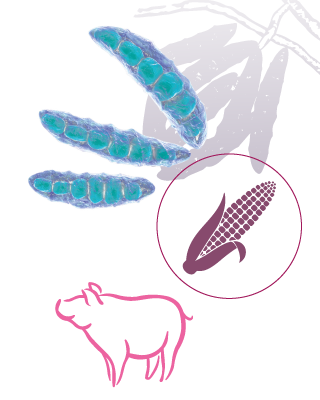
Introduction
According to toxicity and frequency of appearance in nature, Zearalenone (ZON toxin) is one of the most important mycotoxins of Fusarium fungi that are widely spread in Europe (Bottalico and Perrone, 2002; Logrieco et al., 2002).Corn is usually affected, especially hybrids with a long vegetation and high humidity at the moment of harvest, but the fungi growth and toxin synthesis extends further during storage (EFSA, 2004). (EFSA, 2004).
Biological activity
Biological activity of this toxin can be explained as:- Competition with 17 ß oestradiol for the specific binding sites at estrogenic receptors:
- Interpherence with enzymes that are involved in the metabolism of steroids (Mitterbauer et al., 2003).
- F-2 toxin exerts its effects in all metabolic processes that are under the influence of estrogenic hormones, usually on the genital tract and in reproduction (D'Mello et al., 1999).
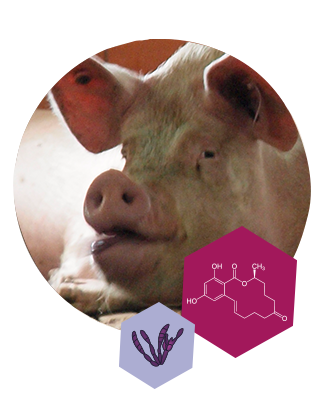
Pigs are sensitive
Pigs are more sensitive than other animal species.(Gaumy et al., 2001)- Primarily manifesting hyperestrogenism in females
- Gastrointestinal lesions
- Effects on the liver
- Alterations of serum clinical chemical parameters (D'Mello et al., 1999; Döll et al., 2003, Döll et al., 2005)
Clinical Signs
In severe cases vaginal and rectal prolapses can be seen.
Clinical signs are more expressed in immature than in mature animals (Doll et al., 2003).
Diarrhoea, vomiting, feed refusal, body weight loss and haemorrhages also can be seen in the clinical picture, but not only as the consequence of zearalenone influence, but by its synergistic effect with other toxins present in the feed contaminated with Fusarium fungi (D'Mello et al., 1999).
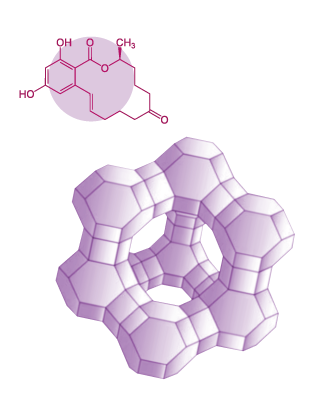
Adsorbents
The use of adsorbents is the most frequent way of alleviating and/or preventing harmful effects of mycotoxins.Adsorbents are substances nonresorbable from the gut that can physically bind some chemicals and thus block their resorption.Several commercially available adsorbents which claimed to bind mycotoxins were tested for both in vitro and in vivo adsorption.
Most studies have used aluminosilicates such as modified clinoptilolite (Tomasevic- Canovi} et al., 2003; Döll et al., 2004, Döll et al., 2005).
The feasibility of utilizing organic adsorbents was recently examined.
Esterified glucomannan, which belongs to this group, (Devegowda et al., 1998; Swamy, 2002) is isolated from the inner layer of yeast cell wall and which possesses a significant capability for mycotoxin adsorption.
Material and methods
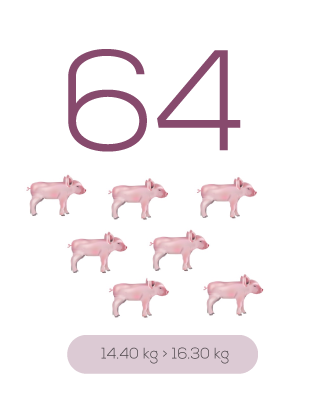
Animals.
- Two trials were performed on a total of 64 pigs of Swedish and Dutch Landrace cross-breed.
- Pigs were of both sexes with 14.40 kg and 16.30 kg average body weight, 60 days old and kept in breeding pens.
- Microclimate and hygienic conditions were appropriate for this category of pigs.
Diets.
- All groups of pigs were fed with a commercial feed mixture (grower 15-25 kg) which consisted of standard feedstuffs and contained enough nutrients to satisfy the requirements of this category.
- Corn naturally contaminated with Zearalenone (12.8 mg/kg) was used in the amount of 30% in experimental groups of the first trial and 40% in the second trial.
- Zearalenone free corn was given to pigs in the control groups.
- Mineral adsorbent Minazel Plus® was introduced in the contaminated feed of the second experimental groups and organic adsorbent Mycosorb® in the contaminated feed of the third experimental groups of both trials.
Data and sample collection.
- The following data were monitored during the
trials:
- body weight (BW),
- weight gain (AWG),
- feed intake (FI)
- feed conversion ratio (FCR)
- Control measurments of the experimental pigs were done on a
technical scale with 10-2 kg precision.
According to these results average body weight was calculated.
- Total weight gain was obtained from body weight difference and daily weight gain was calculated according to duration of the trials.
- The amount of mixes given to each group was measured precisely during both experiments.
- Feed intake was identified after adding of daily amounts of feed at the and of the trials.
- Feed conversion ratio was calculated according to feed intake and weight gain data for both experiments.
- Every day observations were done with special interest to occurrence of diarrhea and vulvovaginitis.
- Vulvovaginitis severity was determined according to vulvar index (Evans, 2000) which was the result of the multiplication of vulvar width and length.
- Six pigs per group were sacrificed at the end of the trials.
- Immediately after sacrifice necropsy and detailed macroscopic examinations were carried out.
- In the shortest possible period samples of vagina were taken for histological investigations.
- Vagina samples were fixed in 10% neutral formalin and absolute alcohol, embedded in paraffin, sections of 5-8 mthickness cut and stained using the standard hematoxylin eosin method (Scheuer and Chalk, 1986).
Results and discussion
Pigs were of adequate body weight for their breed and age at the beginning of the trials and differences were not statistically significant (p>0.05). Performance differed at the end of the trials between control and experimental groups, and also between trials depending on toxin concentracions.
Pigs in the control groups achieved the largest body weight, top weight gain and the lowest feed conversion ratio.
According to literature data it was concluded that these results were common for breed, sex, age and rearing conditions.

Zootechnical conditions and animal health
It is particularly the indicator of zootechnical conditions and animal health (Table 1). By comparing experimental groups (O-I) to control groups (K) considerably lower daily weight gain, for 19.86% (p< 0.05), was seen in the first experiment and 22.27% in the second one.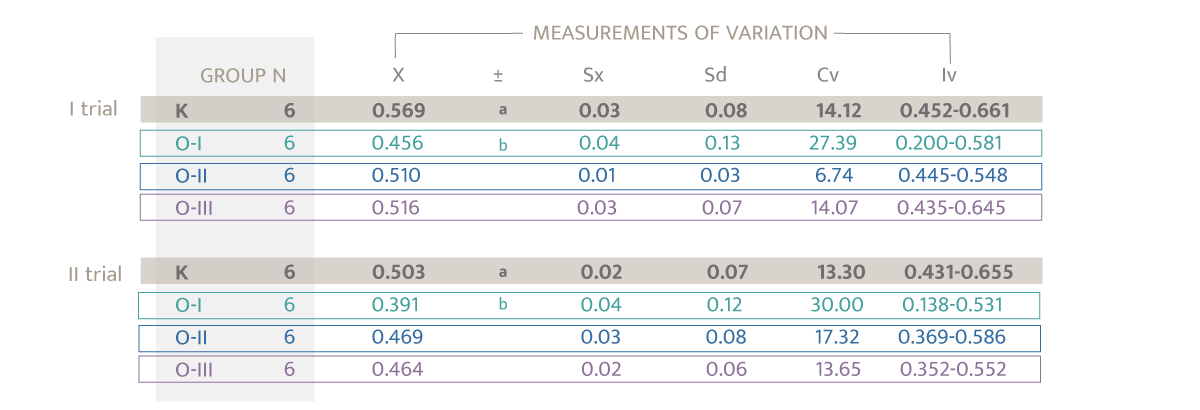 * Value expressed as x±Sd a, b, c, d p <0.05
* Value expressed as x±Sd a, b, c, d p <0.05- Application of adsorbents ensured a significant recompense of lost body weight, i.e. it provided satisfactory daily growth.
- Average body weight and daily weight gain of pigs fed with contaminated feed with addition of adsorbents were still lower than control values, but at the same time higher than average body weight and daily weight gain of pigs fed with contaminated feed without protectors.
- There was not any difference in the results due to type of adsorbent.
It could be concluded that utilizing modified clinoptilolite and esterified Glucomannan was not enough for performance of usual body weight, i.e. it could not entirely prevent harmful effects of Zearalenone, even at its lowest dosage. But, usage of adsorbents alleviated harmful effects of F-2 toxin also in the case of its higher content in the feed.Pigs fed with feed contaminated with a lower quantity of Zearalenone with addition of adsorbents achieved larger consumption than pigs fed with the same feed without protectors, but it was still lower than in the control groups.
Presence of F-2 toxin reduced feed intake for 5.89% in the first trial and 1.52% in the second trial, but the application of adsorbents entirely eliminated harmful effects.
Pigs fed with feed contaminated with higher amount of Zearalenone with addition of adsorbents reached larger feed intake, compared to pigs in the control groups.
There was no significant difference in the results due to type of adsorbent.
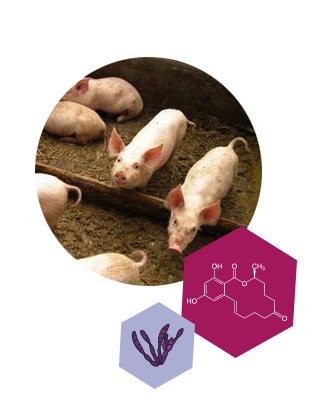
Feed conversion ratio
Feed conversion ratio, as interaction of weight gain and feed intake, differed between control and experimental groups (Table 2).
Utilization of adsorbents significantly alleviated harmful effects of
Zearalenone, but not entirely.
- Feed conversion ratio of pigs fed contaminated feed with the addition of modified clinoptilolite was still higher than control values for 6.52% in the first trial and 8.83% in the second trial, but it was lower than feed conversion ratio of pigs who received contaminated feed only.
- Feed conversion ratio of pigs fed contaminated feed with the addition of esterified Glucomannan was also higher than control values (6.37% in the first experiment and 9.06% in the second) and it was lower than conversion ratio in groups of pigs which did not get adsorbents.
- Döll et al. (2003) also reported that feed intake and, consequently, body weight gain of female weaned piglets receaving Fusarium toxin contaminated diet (ZON 0.42 mg/kg and DON 3.9 mg/kg) were significantly decreased, while the feed conversion ratio was not affected by this treatment.
Clinical signs
Regarding clinical signs this intoxication was manifested by vulvovaginitis in female pigs, but also by nonspecific symptoms of gastrointestinal disorders follow by diarrhea.
Vulvovaginitis occurrence was noticed in all experimental groups of pigs since the third day of ingesting contaminated feed.
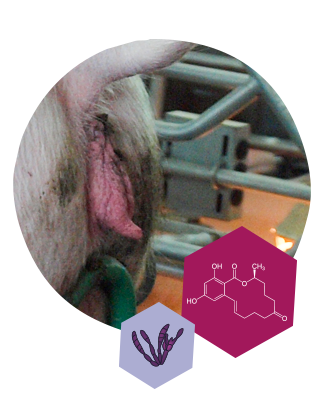
Vulvar oedema could be seen in groups of pigs fed with contaminated mixture without of adsorbents for 10- 15 days after dispossession of this feed.
This symptom was less obvious by addition of adsorbents and it was present for 5-10 days after disuse of contaminated feed.
Table 3. Vulvar index
 *Value expressed as x±Sd a, b, c, d p <0.05 x, y, z, w p ≤<0.01
*Value expressed as x±Sd a, b, c, d p <0.05 x, y, z, w p ≤<0.01
Morphological examination of the genital organs of pigs fed with Zearalenone contaminated feed showed macroscopic changes in the form of vulvovaginitis primarily manifested with oedema.Histological findings of epithelial hyperplasia and submucous oedema were present mostly in pigs that were not given any feed protectors.

Gastrointestinal disorders
- The outbreak of gastrointestinal disorders was also observed.
- It was noticed since the third day of usage of contaminated feed without added adsorbents, and since the seventh day in groups of pigs that were given protectors.
- The majority of affected pigs was seen in groups with no added adsorbents in the feed.
It is believed that this might be result of the presence of other Fusarium mycotoxins which co-occur in the feed. In general, combinations of Fusarium mycotoxins result in additive effects, but synergistic and/or potentiating interactions have been observed and are of great concern in livestock health and productivity. (D'Mello et al., 1999; Jadamus and Schneider, 2002).
Observing performances cumulatively for both experiments it can be found that Zearalenone provoked harmful effects proportionally to its content in the feed (Doll et al., 2003), although this was not obviously clinically noted in the trials considering their similar duration and only a 1.16 mg/kg dosage difference.
Similar results are observed by utilizing an esterified Glucomannan, but still lower than those reported by Devegowda and Aravind (2002) and Aravind et al. (2003).
Addition of modified clinoptilolite and esterified Glucomannan in the feed significantly alleviates harmful Zearalenone effects.
Thus, the use of adsorbents as toxin binders could be an efficient approach to reduce mycotoxin effects in animals to a certain extant.
However, only absolute disuse of this kind of feed is a safe and efficient method of avoiding mycotoxins.
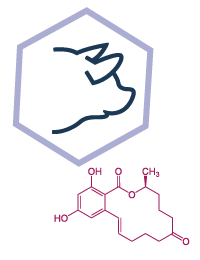



 Micotoxicosis prevention
Micotoxicosis prevention